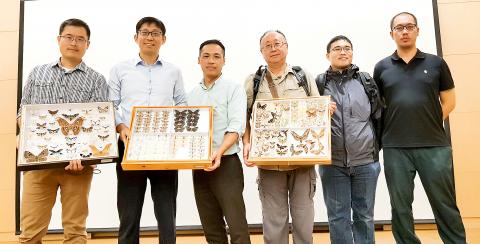Moths living at lower elevations and warmer environments develop richer colors, possibly because those with darker colors can retain more heat in cold regions, an Academic Sinica research team said yesterday.
The correlation between coloration and habitat elevations had been mostly a hypothesis, but the team used an artificial intelligence (AI) tool for image analysis to confirm the phenomenon with quantifiable and consistent data, Shipher Wu (吳士緯), a postdoctoral researcher at the Biodiversity Research Center, told a news conference in Taipei.
Taiwan has nearly 4,400 documented moth species — almost 10 times than the number of documented butterflies in the nation, but less than 10 researchers study moths in this nation, Wu said.

Photo: Chien Hui-ju, Taipei Times
Thanks to an AI-assisted deep learning model, the Academic Sinica team was able to efficiently analyze more than 20,000 images of nearly 2,000 moth species, and found that environmental temperature is a factor affecting species coloration, he said.
The images were gathered by 103 professional and amateur observers who contributed to certain online moth databases from 2011 to 2016, including Council of Agriculture’s Endemic Species Research Institute Deputy Director Lin Hsu-hong (林旭宏), Wu said.
Whether moths with richer colors possess more advantages to help them survive needs further investigation, he added.
The team detailed their findings in a paper published in the journal Nature Communications on Oct. 7, “Artificial intelligence reveals environmental constraints on color diversity in insects,” with Wu as the lead author.
The deep learning model was developed by a group led by Chen Sheng-wei (陳昇瑋), a research fellow at Academia Sinica’s Institute of Information Science and director of the Taiwan AI Academy.
While he has seen AI widely applied in the medical and financial fields, this was the first time he used it, Chen said.
Unlike human eyes, which tend to simplify the traits of visual objects, deep learning can establish relations among a considerable number of images, he said.
Identifying species’ differences through human eyesight is subject to human bias and vision limitation, but AI technology can resolve these problems, said Shen Sheng-feng (沈聖峰), an associate research fellow at the center.
The team is working with Japanese researchers to gather more information of moths that live at higher latitudes, he said.
AI-assisted analysis is a new trend in biological studies, so Taiwan’s pool of information and technological talent gives the nation’s biologists an advantage, Shen said.
While some biologists might feel anxious about using AI in their research, they should consider it just another tool that can help them see better, he said.
Knowledge of biological traits could be used to design camouflage clothing and for other purposes as well, Shen added.

An essay competition jointly organized by a local writing society and a publisher affiliated with the Chinese Communist Party (CCP) might have contravened the Act Governing Relations Between the People of the Taiwan Area and the Mainland Area (臺灣地區與大陸地區人民關係條例), the Mainland Affairs Council (MAC) said on Thursday. “In this case, the partner organization is clearly an agency under the CCP’s Fujian Provincial Committee,” MAC Deputy Minister and spokesperson Liang Wen-chieh (梁文傑) said at a news briefing in Taipei. “It also involves bringing Taiwanese students to China with all-expenses-paid arrangements to attend award ceremonies and camps,” Liang said. Those two “characteristics” are typically sufficient

A magnitude 5.9 earthquake that struck about 33km off the coast of Hualien City was the "main shock" in a series of quakes in the area, with aftershocks expected over the next three days, the Central Weather Administration (CWA) said yesterday. Prior to the magnitude 5.9 quake shaking most of Taiwan at 6:53pm yesterday, six other earthquakes stronger than a magnitude of 4, starting with a magnitude 5.5 quake at 6:09pm, occurred in the area. CWA Seismological Center Director Wu Chien-fu (吳健富) confirmed that the quakes were all part of the same series and that the magnitude 5.5 temblor was

The brilliant blue waters, thick foliage and bucolic atmosphere on this seemingly idyllic archipelago deep in the Pacific Ocean belie the key role it now plays in a titanic geopolitical struggle. Palau is again on the front line as China, and the US and its allies prepare their forces in an intensifying contest for control over the Asia-Pacific region. The democratic nation of just 17,000 people hosts US-controlled airstrips and soon-to-be-completed radar installations that the US military describes as “critical” to monitoring vast swathes of water and airspace. It is also a key piece of the second island chain, a string of

The Central Weather Administration has issued a heat alert for southeastern Taiwan, warning of temperatures as high as 36°C today, while alerting some coastal areas of strong winds later in the day. Kaohsiung’s Neimen District (內門) and Pingtung County’s Neipu Township (內埔) are under an orange heat alert, which warns of temperatures as high as 36°C for three consecutive days, the CWA said, citing southwest winds. The heat would also extend to Tainan’s Nansi (楠西) and Yujing (玉井) districts, as well as Pingtung’s Gaoshu (高樹), Yanpu (鹽埔) and Majia (瑪家) townships, it said, forecasting highs of up to 36°C in those areas